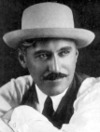

Sennett was impressed enough with Bing's performance at the Grove that he signed him to do a short musical-comedy film that month in which Bing would play himself. The film, I Surrender Dear, was named after Bing's first solo hit recording and was filmed in March, 1931, and released in Los Angeles the following June. The film was so successful that it led to 5 more with Sennett. Bing was paid $750 for each 20-minute picture.
Sennett was more famous for his slapstick and special effects than his dialogue. Crosby worked without formal scripts for these movies ... only outlines. During the filming Crosby found himself dunked in water tanks, chased by lions and half-baked in quick-rising dough. Bing's success with Sennett helped convince him that the time was ripe to leave the Rhythm Boys and get on with his solo career. The Rhythm Boys dissolved following the release of "I Surrender Dear."
The six Sennett two-reelers in the order of their filming were:
"Sing, Bing, Sing" and "Blue of the Night" were released in 1933.